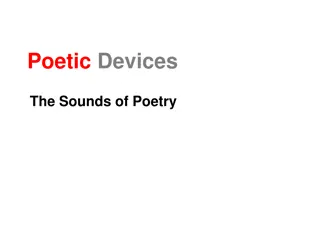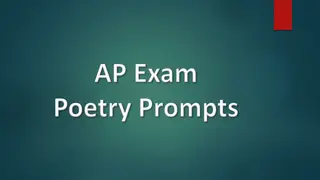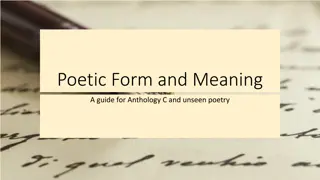Exploring the Power of Time in Poetic Works
Delve into the representation of time in the poems "Tissue" and "Ozymandias," exploring themes of transience, mortality, and the impact of time on empires. Through the poets' insightful reflections, witness the contrast between the fragility and endurance of historical records amid shifting cultural perspectives.
Download Presentation

Please find below an Image/Link to download the presentation.
The content on the website is provided AS IS for your information and personal use only. It may not be sold, licensed, or shared on other websites without obtaining consent from the author. Download presentation by click this link. If you encounter any issues during the download, it is possible that the publisher has removed the file from their server.
E N D
Presentation Transcript
Choose 5 poems from the anthology that you have a lot to say about Link them to a theme . Power of Nature Physical Violence Psychological violence Conflict of war Death Loss Patriotism Memory Inner conflict Men Women Conflict in family Violence Themes Poetic devices Ozymandias Exposure Kamikaze War Photographer Poppies
Compare the ways poets present the power of time in Tissue and one other poem from Power and Conflict Tissue Themes & Context Contemporary Transience of history uncertainty of reality and the truth we tell Language Extended metaphor of paper for recording history but contrasting fragility and longevity of paper Tissue eventually we become paper? Mortality? Recorded in history Free, flow form. =transcience Ozymandias Themes and Context Romantic Time defeats every Empire Language Monolith broken in the sand irony of Look on my works ye mighty and despair Sonnet form permanent yet changing
Structuring a comparative response 1. Comparative introduction - compare themes and context and answer the question 2. Comparative PETAL x 2 with a strong focus on language In Charge of the Light Brigade, Tennyson uses . Whereas in in Exposure . 3. Evaluative conclusion
Introduction Tissue is a challenging poem which defies neat and tidy explanation. This is reflected in its free-flowing structure and elusive imagery. Dharker was born in Pakistan but raised in Glasgow and so has the insight that living between two cultures might bring. It is thus unsurprising that she represents history and our attempts to record time as a confusing layer over layer which Shift[s]/ in the direction of the wind. She comments on both the surprising durability of history and ideas while also acknowledging its fragility and mutability. In contrast, Shelley writes his oft-quoted sonnet to Ozymandias at a point in history when George III was looking to expand the British Empire. At this point England was at the cusp of creating a mighty, world dominating Empire, confident in its military prowess. Thus, Shelley writes this warning to a nation intent on greatness: that even the greatest of Empires are subject to the lone and level sands - the decaying influence of time.
Comparative PETAL The power of time in Tissue is represented through the extended metaphor of paper: paper thinned by age or touching The kind you find in well-used books, The back of the Koran, where hand Has written the names and histories Dharker begins her poems by listing the different ways in which we use paper to record history and she presents it as simultaneously fragile: thinned by age and enduring the Koran representing an ancient and powerful text. A religious text is literally fragile but metaphorically powerful and enduring as it can form the basis for the beliefs and cultural realities of entire cultures and peoples. In contrast, Shelley uses the metaphor of a monolithic vast and trunkless legs of stone to represent the transience of human achievement. He exaggerates the enormity of the statue ( vast ) but also its brokenness: on the sand,/ Half sunk, a shattered visage lies through the short, descriptive list. The sand represents the sands of time and the face of this great despot is little more than a ruin in a desert. Thus Shelley uses one of the most enduring substances imaginable to represent the transience of human endeavour while Dharker suggests that the very fragility and mutability of tissue which let[s] the daylight break/ through capitals and monoliths is what enables it to thin and























